-
收藏模板
- 模板信息
- 更新时间:2023-09-24
- 字数:约11539字
- 页数:约9页
- 格式:.doc
- 推荐版本:Office2016及以上版本
- 售价:5 金币
您可能喜欢的文档
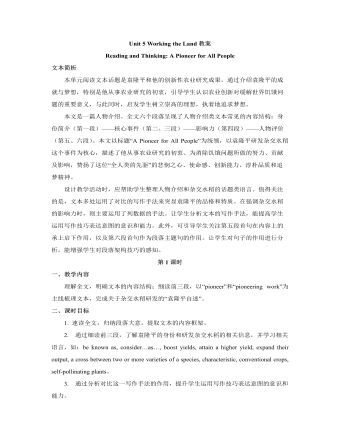
新人教版高中英语选修1Unit 5 Working the Land教案
1. 完成文本主要信息填空(斜体字部分设空):As a witness to farmers’ poor harvests and even a severe shortage of food, Yuan Longping was determined to devote his life to tackling this crisis. After graduation, he realized that what farmers needed most was to boost yields in the fields. Yuan was convinced that the answer lay in the creation of hybrid rice, one characteristic of which is that it usually achieve higher output than conventional crops. However, it was no easy job. The first difficulty he needed to overcome was scientists’ general assumption that this could not be done. Through trial and error, Yuan managed to generate this incredible crop. It is estimated that about 60 percent of domestic rice consumption in China was comprised of crops generated from Yuan’s hybrid strains. His innovation has enabled Chinese farmers to considerably expand their output and helped feed the world. Unwilling to retire early to a life of leisure and unconcerned about celebrity or fortune, Yuan continues to turn one vision after another into realities.2. 模仿写作:Do some research via the Internet and introduce another agricultural scientist, Chen Risheng(陈日胜), using the structure, expressions and writing techniques you have learnt from the text “A Pioneer for All People”.【设计意图】任务1是对文本内容和词汇学习成效的检测。任务2借助文本中学到的词汇和写作手法仿写另一位科学家,提升学生迁移运用词汇、文体结构和写作方法的能力。
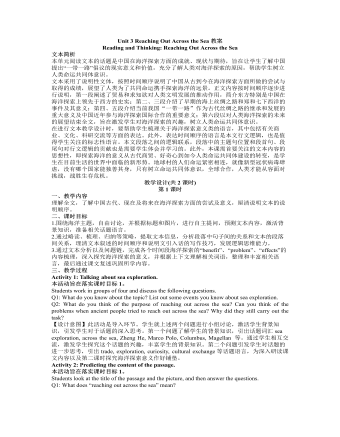
新人教版高中英语选修4Unit 3 Reaching Out Across the Sea教案
本活动旨在落实课时目标3。 Think about the following questions and talk about your own attitude in pairs.Q1: As for this topic,what impresses you the most in the passage?Q2: What do you think of the future of China’s further exploration in sea? Are you in favor of the further exploration?Why or why not? 【设计意图】该活动是一个完全开放性的活动,每个学生都会有不同的答案。运用迁移所学,自由口头表达自己对海洋探索的态度。对于中国海洋探索的未来,每个人的想法是不一样的,有乐观,有担忧,有认为值得投入,也有认为不值得付出太大代价,这里给学生自由表达的空间只要学会有支撑自己观点的事实就可以了,进一步培养学生批判性思维和正确的价值观。 Assignment: 此任务旨在迁移一、二课时所学,培养学生辩证分析问题的能力。 Write about your idea of the future of China’s sea exploration. And add your attitude towards the effort China have made in sea exploration. You’re expected to use the language and the writing technique learnt in the passage.
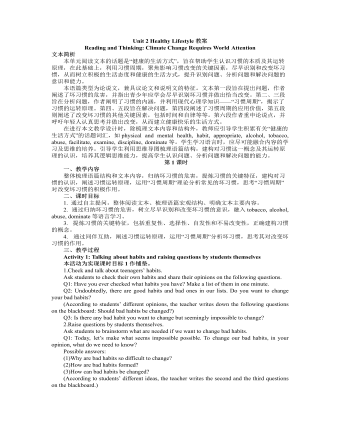
新人教版高中英语选修3Unit 2 Healthy Lifestyle教案
Activity 4: Figuring out the structure and the writing purpose 本活动为实现课时目标2。 1.Read Paragraph 6 and think about its main idea and the writer’s writing purpose. Q1: If you were the author, how would you end your article? “For young people, there is plenty of time to change bad habits. However, there is no “magic pill” or delete button that will help you; you have to think about your bad habits and decide on some changes. You have the power to build a happy and healthy life full of good habits!” Q2: What is Paragraph 6 mainly about? (Possible answer: to appeal to young people including teenagers to change bad habits and live a happy and healthy life.) 2.Think about the writer’s writing purpose and share opinions. Q1: What is the writing purpose? Work in pairs and figure it out. (Possible answer: On the one hand, the passage is written to help teenagers change their bad habits and live a healthy lifestyle. On the other hand, it provides us with a scientific way to identify and analyse our problems objectively, thus strengthening our resolve to tackle the seemingly common yet tough problems in our lives.) 【设计意图】 步骤1旨在预测和验证文章最后一段主要内容,梳理完整的语篇结构,步骤2旨在思考和讨论作者的写作目的。教师也可根据学生课堂反应情况融入对语篇人称多次转换的思考。
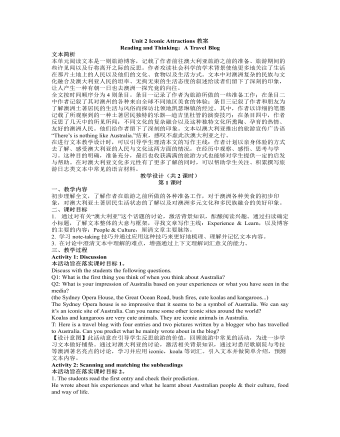
新人教版高中英语选修4Unit 2 Iconic Attractions教案
帮助学生通过讨论与对主题的提升,反思自己的旅游方式,以便做出更优化的安排,在今后的旅程中有更多的收益。 Activity 2: Further discussion of the 6 elements above and supplement of more background knowledge 本活动为实现课时教学目标2。 1.Target Q: The writer’s clear target of traveling, meeting the people and experiencing the culture, is closely related to his major in social studies. Then what is social studies? Social studies is a part of a school or college curriculum concerned with the study of social relationships and the functioning of society and usually made up of courses in history, government, economics, civics, sociology, geography, and anthropology. (Dictionary by Merriam-Webster) Reflection: When you go out to travel, what targets do you usually have in mind? 2.Research Q: Suppose you are traveling to Hangzhou during the school holidays, how will you do research on the city? (surf the internet, read books or travel brochures, consult friends, ...) What information will you be interested to know? (location, iconic sites, local cuisines, interesting customs, shopping malls ...) 3.Abandonment To make the most of time, we have to learn to abandon so that we can accomplish our plan. What will you be interested in doing if you go to Hangzhou if you have a week’s time? What if you only have 2 days? 4~5. Venturing & Experiencing Q: What did he venture to do during the trip? What new experiences did he have? In Sydney: attend his first open-air barbecue, enjoy many different but yummy meals In Catherine: observe the life and customs of the aborigines appreciate their music & try the musical instruments: the didgeridoo
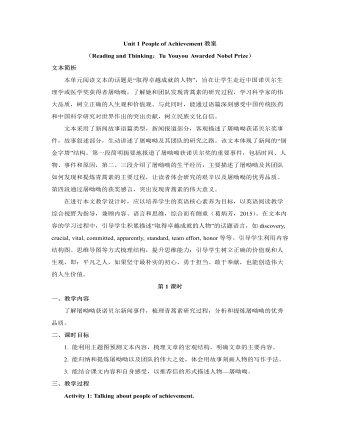
新人教版高中英语选修1Unit 1 People of Achievement教案
【设计意图】 基于上述分析,学生总结新闻故事语篇类型的特征,即标题的省略性、导语的概括性、数据的支撑性和引语的重要性。在此过程中,学生对新闻故事语篇类型有了更深层次的了解,对于学生阅读和写作具有重要意义。Activity 7: Discussing to make a writing outline.本活动为实现课时目标3。1.Discuss and make an outline.Ask students to discuss in groups of four and make their own writing outline.To celebrate the 70th anniversary of the People’s Republic of China, our school newspaper starts a new column about “People of Achievement”. You plan to write a news story about one of the winners of the Medal of the Republic in 2019, including Yu Min, Shen Jilan, Sun Jiadong, Li Yannian, Zhang Fuqing, Yuan Longping, Huang Xuhua and Tu Youyou.【设计意图】 教师创设情境,即为庆祝新中国成立70周年,校报新增有关卓有成就人物的栏目,你将从共和国勋章获得者中,选择一位写一篇新闻故事,向该栏目投稿。学生以小组合作形式,展开讨论,并写出新闻故事框架,有助于学生课后收集人物信息,撰写新闻故事。
- 查看更多相关Word文档
Unit2 Looking into the Future教案
(Readingand Thinking:Smart Homes to Make LifeEasier)
文本简析
本单元的主题是“展望未来(Lookinginto the Future)”,阅读文本的话题是“智能家居使生活更加便利(SmartHomes to Make Life Easier)”。文中,作者介绍了未来家居的智能化水平,展示了科技发展能给生活带来很多便利,并引发读者思考这些变化可能产生的问题。在“未来”和“科技”的主题语境下,作者选择家居生活作为描写和说明的对象,缩短了读者与主题语境以及文本内容的距离,有利于引起阅读兴趣,引发读者共鸣。

本文是一篇科技小品文。全文五个段落呈现了说明类文本常见的BTEC的内容结构:第一段介绍了背景(Background)和主题(Topic),即在目前家居生活不够安全和节能等背景下,提出未来智能家居可以给我们提供更安全、更节能和更舒适的生活这一主题;第二至第四段用“智能控制、健康检查和防范灾害”三种功能解释了文本主题(Explanation);第五段是总结(Conclusion),智能家居时代已经到来但其推广普及还需要一段时间。本文的写作目的是为了让读者了解未来家居的智能化水平及其为生活带来的便利,引导学生结合文章主题和内容形成对未来科技发展的积极期待和全面思考,形成对未来科技客观理性的态度。
在本文的阅读教学中,首先要关注文体特征,包括文本标题、小标题以及语篇标识语,并利用这些特征理解文本结构、写作目的和目标读者;其次,在了解未来家居智能化水平和给生活带来的便利时,可同时整理相关的话题语言;此外,文本用问句开头、多处运用对比和引证的写作手法,并用语法结构“will be doing”来表明态度,这些都是很好的使用写作技巧的范例,能提高学生运用合适的写作技巧来表情达意的意识和能力;最后,在对“智能家居有什么特征”和“为何智能家居一时还不能普及”等问题的探讨中,学生的深度思维能力尤其是批判性思维能力可以得到有效训练。
第1课时
一、教学内容
理解全文,明确文本的内容结构;细读前两段,以“smart”和“easier”为核心梳理文本,了解关于未来家居的智能化水平程度和对我们生活的影响,学习相关语言。
二、课时目标
1. 通过速读题目和小标题,提取文本的内容框架,了解写作目的和目标读者。
2. 通过细读前两段,了解未来家居的智能化水平以及它们给生活带来的便利,并学习相关语言,如:keep us secure, save usenergy, and provide a more comfortable environment to live in。
3. 通过分析用问句开头和对比等写作手法的作用,提升学生运用写作技巧表达意图的意识和能力。
4. 通过角色代入式复述,巩固内容和语言。
三、教学过程
Activity1: Warming-up
本活动为落实所有课时目标做铺垫。
Discuss thepossible differences between the household appliances of today and in thefuture.
The teacherinitiates the discussion by mentioning her experience of choosing householdappliances for her two houses, the old one twenty years ago and the new onelast year.
T: Greatchanges have taken place in household appliances. What will happen to them inthe future, e.g., another twenty years later?
【设计意图】通过讨论现在和二十年前家用电器的差异,学生了解科技发展给家居生活带来的变化,并展望二十年之后的情况。这个话题接近生活,每个学生都有话可讲,同时也为后续“智能家居让生活变得更加便利”作好思维的比较性铺垫。另外,用家电作为切入点引起有关智能家居的话题也可以为阅读解决一些词汇障碍,如:appliance,switch,knob,remotecontrol,automatic,voicecommand等。
Activity2: Reading for the writing purpose and the intended audience
本活动旨在实现课时目标1。
Read thetitle and the three subtitles.
Q1: What isthe purpose of the text? (To introduce smart homes.)
Q2: Who isthe intended audience of this text? (People who welcome smart homes / newtechnology.)
【设计意图】通过阅读文本题目及其三个小标题,了解文章的体裁和结构,推测写作目的和目标读者。
Activity 3: Reading Paragraph 1 for thetopic
本活动旨在落实课时目标2和3.
ReadParagraph 1 and answer the following questions:
Q1: Whatproblems do we have today?
Forget tolock ...; forget to switch off ...
Q2: What doyou think of living in a regular home today?
Annoying /high resource-consuming / dangerous /...
Q3: How willthese problems be solved in the not-too-distant future?
We will beliving smart homes that will lock…and switch off…
Q4: Whatdifference will smart homes make to our life?
…keep ussecure, save us energy, and provide a more comfortable environment to live in…
Q5: How doesthe writer introduce the topic?
Bycontrasting.
Q6: Why doesthe author use two questions at the very beginning of Paragraph 1?
To getreaders attention or raise their interest.
【设计意图】在“Smart Homes to MakeLife Easier”统领下,引起对家居生活现状和存在问题的共鸣,接着了解智能家居能给生活带来的变化,呈现主题;同时,学生感知在文本开头设问引起读者兴趣和用比较凸显主题意义的写作手法,提高用写作手法表情达意的意识和能力。
Activity4:Predicting about Paragraphs 2-5 andthen confirming the predictions
本活动旨在落实课时目标2和目标3。
1.Make aprediction about the contents in the following parts.
Q: What doyou think will be talked about in the following parts?
Possiblepredictions:
- anintroduction to the technology which makes future homes smart;
- someexample functions of smart homes;
- theexpense of smart homes;
- therelationship between smart technology and humans;
...
2. ReadParagraphs 2-5 inpidually to confirm the predictions.
3. Sharereading experience with other readers.
Q: Whatimpressed you most while reading? Why does it impress you? Or do you have anyquestions? If yes, what are they?
【设计意图】学生预测文本内容,形成“想知内容”,接着去文本中验证自己的预测。这种带着任务的阅读可以帮助学生自然地走进文本,不仅满足了学生的好奇心,也厘清了文本的基本脉络。另外,在验证预测后再跟进阅读体验分享,学生在聚焦、分享自己的兴趣点或探讨问题的同时可以进一步熟悉文本,思维深度也逐渐增加。
Activity5: Reading Paragraph 2 for its connection to the topic
本活动旨在落实课时目标2和3。
1. ReadParagraph 2 carefully and try to find out its link to the topic.
Q1: Whatproblems do we have today?
Today, we have to use… for …
Q2: What doyou think of living in a regular home today?
Answers mayvary.
Q3: How willthese problems be solved in the future?
In thefuture, we will be using advanced technology every day for automatic control ofjust about everything in our home.
Q4: Whatdifference will smart homes make to our life?
*What cansmart homes do?
*Whatdifference will they make?
*Whattechnological support do they need?
Theinformation of Q4 can be sorted out like this:
Q5: How doyou understand the word “intelligent”? Why?
Answers mayvary. For example:
Multifunctional.Because it can function in many ways, even at the same time.
【设计意图】在第一段即主题段的统领下阅读第二段,并建立第二段和主题之间的联系。第一个联系点是文段的建构方法,作者继续用今天和未来作比较的方法建构第二段,以此凸显“智能控制”给生活带来的便利;第二个联系点是所有“智能控制”的功能和便利之处都是围绕主题展开的,即“安全、环保和舒适”。在此基础上,学生开始探索智能家居的技术支持,透过表象看本质,为最终把思维的落脚点放在科技上做好准备。最后,学生对intelligent 一词进行多维理解,并用文本中的信息来支撑自己的理解,拓宽主题范围。
Activity6: Talking about the topic and using its language
本活动旨在落实课时目标4。
If you aretaking part in an English speech contest about future life, please give aspeech titled “Smart Homes, Easier Life”. You are supposed to include:
1. a basicintroduction to our present life,
2. thefunctions of future smart homes, and ...
3. thedifference smart homes will make to our life.
Ifnecessary, you may as well use questions at the beginning to interest yourreaders.
【设计意图】该任务是巩固话题内容和语言的活动。根据“目前问题—解决方法—产生变化”的思路,学生再次回顾文本,比较现在和未来的家居生活差异,凸显智能家居给生活带来的变化,加深对智能家居功能和作用的印象,从而深刻理解高科技对人类生活产生的积极意义。
Assignment:
1.Polishyour writing of speech—“Smart Homes, Easier Life”, and prepare for a classpresentation in the next period;
2.Build alanguage bank related to smart homes.
【设计意图】通过润色演讲稿,学生可以再次复习话题内容和语言,提高语言输出需要精致的意识和习惯;通过自己动手整理话题词汇,学生积累语言知识,增加语料库,促进主动学习的意识和能力。
第2课时
一、教学内容
细读文本第三至第五段,继续以“smart”和“easier”为核心理解和评价文本信息,理解文本主题,形成对科技发展的个性化理解和态度。
二、课时目标
1.通过细读、分析第三、四两段,了解“定期健康检查”和“防范灾难”两种功能及相关话题语言,关注文段结构和语篇标识语in addition,并学习使用例证的说明方法。
2.细读第五段,了解智能家居的普及程度,分析其尚未普及的原因,了解智能家居可能存在的隐患。
3.结合智能家居的功能和特点,探讨名人名言“The best way to predict the future is to create it.”,挖掘文本的深层价值,引导学生客观看待科技发展。
4.用小组讨论的形式表达自己对科技发展的态度,迁移使用文本内容和话题语言,促进思维能力发展。
三、教学过程
Activity 1: Making a presentation
本活动为所有课时目标作铺垫。
Activate theknowledge of the text topic and key information about Paragraphs 1-2
1. Presentthe prepared speech — “Smart Homes, Easier Life”.
2. Reviewthe topic of the text.
Q: Whatdifference can smart homes make to our life?
Keep ussecure, save us energy, and provide a more comfortable environment to live in.
【设计意图】通过演讲活动,激活对文本主题和第一、二两段核心信息的记忆,回忆文本内容,使用相关话题语言;同时,通过分享,学生之间可以相互学习、取长补短。这部分也是本节课的热身活动,最后的关注点落到文本主题上。
Activity2: Reading Paragraphs 3-4 for their connection to the topic
本活动旨在落实课时目标1。
ReadParagraphs 3-4 carefully and find their link to the topic.
Q1: What cansmart homes do for us according to Paragraphs 3-4?
Monitor ourhealth and prevent disasters from happening.
Q2: How willsmart homes monitor our health and prevent disasters from happening?
Q3: How doesthe writer organize information in Paragraphs 3-4?
Paragraph 3:
Paragraph 4:
Q4: Whatdifference will smart homes make to life in terms of these two paragraphs?
Keeping ussecure.
Q5: How doesthe writer connect these two paragraphs to the former parts?
By using “inaddition”.
Q6: What’sthe writer’s attitude to smart homes?
Answers mayvary here. In addition to other possible ideas, the teacher mentions that thewriter uses “will be doing” to show his favor to smart homes. “Will be using”is often used when something is happening with certainty. Besides, peopleusually use it to show their favor to the thing that is about to happen.
【设计意图】结合主题意义,学生细读第三、四两段,了解智能家居在未来如何保证我们的安全。在理解内容、习得话题语言的基础上,学生学习说明类段落的建构方法,关注语篇标识语in addition的用法,并学习willbe doing在表达作者态度方面的作用,了解结构、语篇标识语和语法结构在表情达意方面的作用,提高这方面的意识和能力。
Activity3: Reading Paragraph 5 for the conclusion of the topic
本活动旨在落实课时目标2和目标3。
ReadParagraph 5 to transfer focus from advantages to disadvantages.
Q1: Arethese smart homes only a fantasy?
It is not afantasy.
Q2: Whatdoes “in this sense” in the third sentence mean?
Many of these new innovations are alreadyavailable and being used in some homes.
Q3: Can youparaphrase the sentence “The home tomorrow is already the home of today”?
The era ofsmart homes has already come.
Q4: Are theyenjoying their popularity?
Not yet. Itwill take some years before most new homes begin to use this new technology.
Q5: Why willit take some years before most new homes begin to use this new technology?
Some possibledisadvantages:
high cost;imperfect technology; risk of leaking personal information; unpopularity amongsome people, e.g. senior citizens; ...
Q6: Willsmart technology outsmart humans one day?
Answers mayvary.
Q7: Why dohumans create high-tech products like smart homes since smart technology poseschallenges to us?
Answers mayvary. In addition to other possible answers, the teacher shares herunderstanding of the sentence —The best way to predict the future is to createit.
【设计意图】通过思考“智能家居是否只是一个幻想”,学生了解智能家居目前的发展情况,并探究其尚未普及的原因,批判性思考智能家居潜在的缺点;在此基础上,学生思考并表达智能家居和人类的关系,理解人类发展科技是为了给自己创造更好的生活,提升对文本主题意义的理解。随后,教师提问引导,师生共同探讨德鲁克的名言“The best way to predictthe future is to create it.”,明确人类发展科技是为了给自己创造更美好的生活,而科技的发展前景由人类自己决定,培养学生对科技发展的客观和理性的态度。
Activity4. Voicing your opinions about the topic and using its language
本活动旨在落实课时目标4。
转载请注明出处!本文地址:
https://www.lfppt.com/worddetails_92360551.html最新课件教案文档
-

精选高中生期末评语
1、该生学习态度端正 ,能够积极配合老师 ,善于调动课堂气氛。 能够积极完成老师布置的任务。学习劲头足,听课又专注 ,做事更认 真 ,你是同学们学习的榜样。但是,成绩只代表昨天,并不能说明你 明天就一定也很优秀。所以,每个人都应该把成绩当作自己腾飞的起 点。2、 你不爱说话 ,但勤奋好学,诚实可爱;你做事踏实、认真、为 人忠厚 ,是一个品行端正、有上进心、有良好的道德修养的好学生。在学习上,积极、主动,能按时完成老师布置的作业,经过努力 ,各 科成绩都有明显进步,你有较强的思维能力和学习领悟力,学习也有 计划性,但在老师看来,你的潜力还没有完全发挥出来,学习上还要有持久的恒心和顽强的毅力。
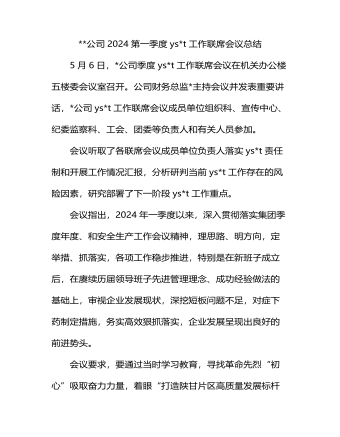
公司2024第一季度意识形态工作联席会议总结
一是要把好正确导向。严格落实主体责任,逐条逐项细化任务,层层传导压力。要抓实思想引领,把理论学习贯穿始终,全身心投入主题教育当中;把理论学习、调查研究、推动发展、检视整改等有机融合、一体推进;坚持学思用贯通、知信行统一,努力在以学铸魂、以学增智、以学正风、以学促干方面取得实实在在的成效。更加深刻领会到******主义思想的科学体系、核心要义、实践要求,进一步坚定了理想信念,锤炼了政治品格,增强了工作本领,要自觉运用的创新理论研究新情况、解决新问题,为西北矿业高质量发展作出贡献。二是要加强应急处事能力。认真组织开展好各类理论宣讲和文化活动,发挥好基层ys*t阵地作用,加强分析预警和应对处置能力,提高发现力、研判力、处置力,起到稳定和引导作用。要坚决唱响主旋律,为“打造陕甘片区高质量发展标杆矿井”、建设“七个一流”能源集团和“精优智特”新淄矿营造良好的舆论氛围。三是加强舆情的搜集及应对。加强职工群众热点问题的舆论引导,做好舆情的收集、分析和研判,把握时、度、效,重视网上和网下舆情应对。
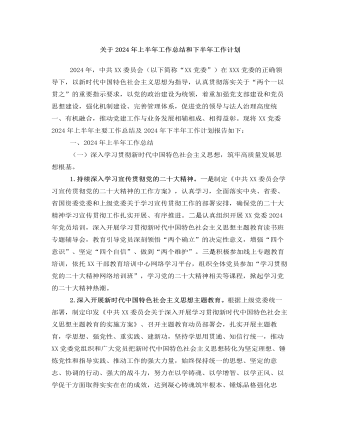
关于2024年上半年工作总结和下半年工作计划
二是深耕意识形态。加强意识形态、网络舆论阵地建设和管理,把握重大时间节点,科学分析研判意识形态领域情况,旗帜鲜明反对和抵制各种错误观点,有效防范处置风险隐患。积极响应和高效落实上级党委的决策部署,确保执行不偏向、不变通、不走样。(二)全面深化党的组织建设,锻造坚强有力的基层党组织。一是提高基层党组织建设力量。压实党建责任,从政治高度检视分析党建工作短板弱项,有针对性提出改进工作的思路和办法。持续优化党建考核评价体系。二是纵深推进基层党建,打造坚强战斗堡垒。创新实施党建工作模式,继续打造党建品牌,抓实“五强五化”党组织创建,广泛开展党员教育学习活动,以实际行动推动党建工作和经营发展目标同向、部署同步、工作同力。三是加强高素质专业化党员队伍管理。配齐配强支部党务工作者,把党务工作岗位作为培养锻炼干部的重要平台。
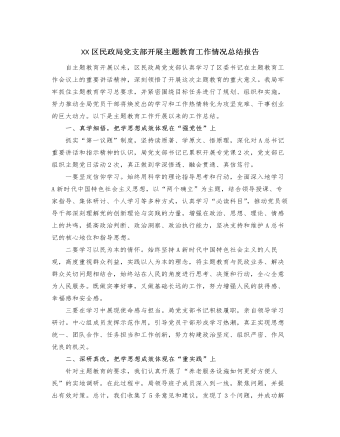
XX区民政局党支部开展主题教育工作情况总结报告
二要专注于解决问题。根据市委促进经济转型的总要求,聚焦“四个经济”和“双中心”的建设,深入了解基层科技工作、学术交流、组织建设等方面的实际情况,全面了解群众的真实需求,解决相关问题,并针对科技工作中存在的问题,采取实际措施,推动问题的实际解决。三要专注于急难愁盼问题。优化“民声热线”,推动解决一系列基层民生问题,努力将“民声热线”打造成主题教育的关键工具和展示平台。目前,“民声热线”已回应了群众的8个政策问题,并成功解决其中7个问题,真正使人民群众感受到了实质性的变化和效果。接下来,我局将继续深入学习主题教育的精神,借鉴其他单位的优秀经验和方法,以更高的要求、更严格的纪律、更实际的措施和更好的成果,不断深化主题教育的实施,展现新的风貌和活力。
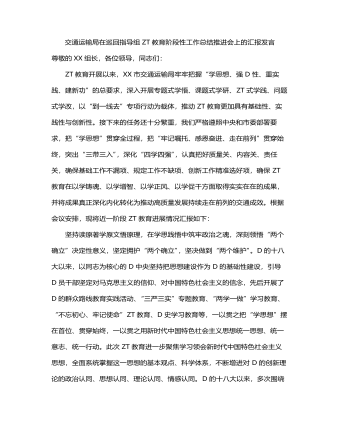
交通运输局在巡回指导组主题教育阶段性工作总结推进会上的汇报发言
今年3月,市政府出台《关于加快打造更具特色的“水运XX”的意见》,提出到2025年,“苏南运河全线达到准二级,实现2000吨级舶全天候畅行”。作为“水运XX”建设首战,谏壁闸一线闸扩容工程开工在即,但项目开工前还有许多实际问题亟需解决。结合“到一线去”专项行动,我们深入到谏壁闸一线,详细了解工程前期进展,实地察看谏壁闸周边环境和舶通航情况,不断完善施工设计方案。牢牢把握高质量发展这个首要任务,在学思践悟中开创建功之业,坚定扛起“走在前、挑大梁、多做贡献”的交通责任,奋力推动交通运输高质量发展持续走在前列。以学促干建新功,关键在推动高质量发展持续走在前列。新时代中国特色社会主义思想着重强调立足新发展阶段、贯彻新发展理念、构建新发展格局,推动高质量发展,提出了新发展阶段我国经济高质量发展要坚持的主线、重大战略目标、工作总基调和方法论等,深刻体现了这一思想的重要实践价值。
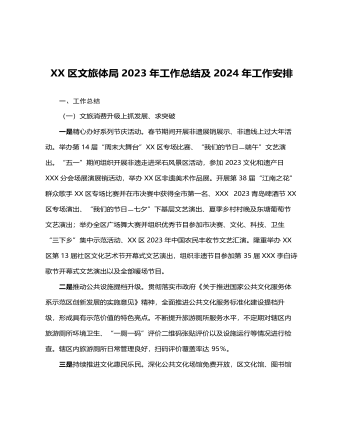
XX区文旅体局2023年工作总结 及2024年工作安排
三、2024年工作计划一是完善基层公共文化服务管理标准化模式,持续在公共文化服务精准化上探索创新,围绕群众需求,不断调整公共文化服务内容和形式,提升群众满意度。推进乡镇(街道)“114861”工程和农村文化“121616”工程,加大已开展活动的上传力度,确保年度目标任务按时保质保量完成。服务“双减”政策,持续做好校外培训机构审批工作,结合我区工作实际和文旅资源优势,进一步丰富我市义务教育阶段学生“双减”后的课外文化生活,推动“双减”政策走深走实。二是结合文旅产业融合发展示范区,全力推进全域旅游示范区创建,严格按照《国家全域旅游示范区验收标准》要求,极推动旅游产品全域布局、旅游要素全域配置、旅游设施全域优化、旅游产业全域覆盖。
今日更新Word
-

精选高中生期末评语
1、该生学习态度端正 ,能够积极配合老师 ,善于调动课堂气氛。 能够积极完成老师布置的任务。学习劲头足,听课又专注 ,做事更认 真 ,你是同学们学习的榜样。但是,成绩只代表昨天,并不能说明你 明天就一定也很优秀。所以,每个人都应该把成绩当作自己腾飞的起 点。2、 你不爱说话 ,但勤奋好学,诚实可爱;你做事踏实、认真、为 人忠厚 ,是一个品行端正、有上进心、有良好的道德修养的好学生。在学习上,积极、主动,能按时完成老师布置的作业,经过努力 ,各 科成绩都有明显进步,你有较强的思维能力和学习领悟力,学习也有 计划性,但在老师看来,你的潜力还没有完全发挥出来,学习上还要有持久的恒心和顽强的毅力。
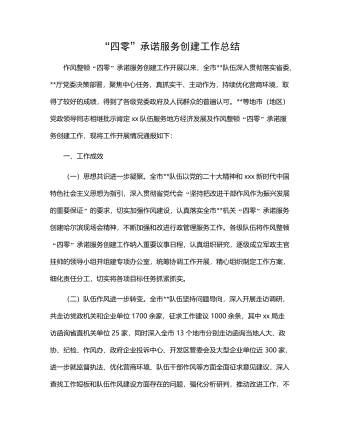
“四零”承诺服务创建工作总结
(二)坚持问题导向,持续改进工作。要继续在提高工作效率和服务质量上下功夫,积极学习借鉴其他部门及xx关于“四零”承诺服务创建工作的先进经验,同时主动查找并着力解决困扰企业和群众办事创业的难点问题。要进一步探索创新,继续优化工作流程,精简审批程序,缩短办事路径,压缩办理时限,深化政务公开,努力为企业当好“保姆”,为群众提供便利,不断适应新时代人民群众对政务服务的新需求。(三)深化内外宣传,树立良好形象。要深入挖掘并及时总结作风整顿“四零”承诺服务创建工作中形成的典型经验做法,进一步强化内部宣传与工作交流,推动全市创建工作质效整体提升。要面向社会和公众庄严承诺并积极践诺,主动接受监督,同时要依托电台、电视台、报纸及微信、微博等各类媒体大力宣传xx队伍作风整顿“四零”承诺服务创建工作成果,不断扩大社会知情面和群众知晓率。
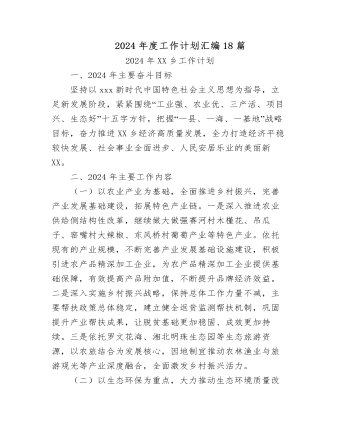
2024年度工作计划汇编(18篇)
1.市政基础设施项目5项,总建设里程2.13km,投资概算2.28亿元。其中,烔炀大道(涉铁)工程施工单位已进场,项目部基本建成,正在办理临时用地、用电及用水等相关工作;中铁佰和佰乐(巢湖)二期10KV外线工程已签订施工合同;黄麓镇健康路、纬四路新建工程均已完成清单初稿编制,亟需黄麓镇完成图审工作和健康路新建工程的前期证件办理;公安学院配套道路项目在黄麓镇完成围墙建设后即可进场施工。2.公益性建设项目6项,总建筑面积15.62万㎡,投资概算10.41亿元。其中,居巢区职业教育中心新建工程、巢湖市世纪新都小学扩建工程已完成施工、监理招标挂网,2月上旬完成全部招标工作;合肥职业技术学院大维修三期已完成招标工作,近期签订施工合同后组织进场施工;半汤疗养院净化和医用气体工程已完成招标工作;半汤疗养院智能化工程因投诉暂时中止;巢湖市中医院(中西医结合医院)新建工程正在按照既定计划推进,预计4月中下旬挂网招标。
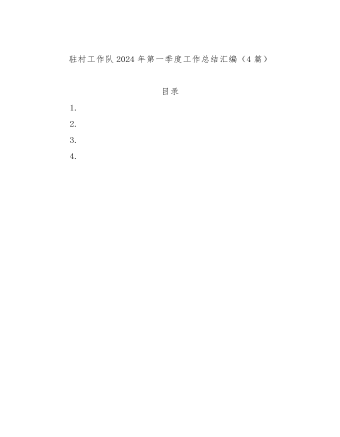
驻村工作队2024年第一季度工作总结汇编(4篇)
三是做大做强海产品自主品牌。工作队于xx年指导成立的冬松村海产品合作社,通过与消费帮扶平台合作,在工作队各派出单位、社会团体、个人支持下,已获得逾xx万元销售额。2022年底工作队推动合作社海产品加工点扩建的工作方案已获批,待资金下拨后将正式启动扩建工作。四是积极助企纾困,带动群众增收致富。工作队利用去年建立的xx镇产业发展工作群,收集本地企业在产品销售、技术、人力、资金、运营、用地等方面的需求,并加大xx支持乡村振兴力度,xx助理赴各村委开展多场xx政策支持乡村振兴宣讲活动,本季度有x万元助农贷款获批,xx万贷款正在审批中。在壮大既有产业的同时,完善联农带农机制,一方面鼓励企业雇用本地农户就业,另一方面计划与本地农户签订长期收购合同,让农民种得放心、种得安心,带动当地群众共同致富。

主题教育总结常用提纲大全
第一,主题教育是一次思想作风的深刻洗礼,初心传统进一步得到回归。第二,主题教育是一次沉疴积弊的集中清扫,突出问题进一步得到整治。第三,主题教育是一次强化为民服务的生动实践,赤子之情进一步得到提振。第四,主题教育是一次激发创业担当的有利契机,发展层次进一步得到提升。2.第一,必须提领思想、武装思想。第二,必须聚焦问题、由表及里。第三,必须领导带头、以上率下。第四,必须务实求实、认真较真。3.一是抬高政治站位,坚持大事大抓。二是坚持思想领先,狠抓学习教育。三是突出问题导向,深入整改纠治。四是坚持领导带头,发挥表率作用。4.一是立足“早”字抓筹划。二是着眼“活”字抓学习。三是围绕“统”字抓协调。5.一是形势所需。二是任务所系。三是职责所在。四是制度所定。6.一要提升认识。二要积极作为。三要密切协作。
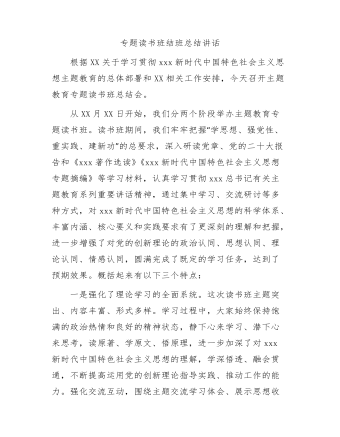
主题教育专题读书班结班总结讲话
第二,要把调查研究贯穿始终,实干担当促进发展。开展好“察实情、出实招”“破难题、促发展”“办实事、解民忧”专项行动,以强化理论学习指导发展实践,以深化调查研究推动解决发展难题。领导班子成员要每人牵头XX个课题开展调查研究,XX月底前召开调研成果交流会,集思广益研究对策措施。各部门、各单位要制定调研计划,通过座谈访谈、问卷调查、统计分析等方式开展调查研究,解决工作实际问题,帮助基层单位和客户解决实际困难。第三,要把检视问题贯穿始终,廉洁奉公树立新风。认真落实公司主题教育整改整治工作方案要求,坚持边学习、边对照、边检视、边整改,对标对表xxx新时代中国特色社会主义思想,深入查摆不足,系统梳理调查研究发现的问题、推动发展遇到的问题、群众反映强烈的问题,结合巡视巡察、审计和内外部监督检查发现的问题,形成问题清单。

















